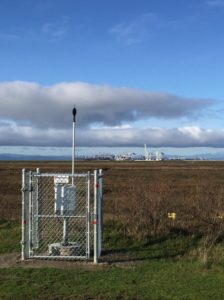The port authority’s noise monitoring program is designed to help us better understand the source and intensity of port-related noises and respond to community concerns regarding noise.
Since 2013, we have worked with partners and vendors to deploy and maintain a series of permanent noise monitoring terminals along the north and south shores of Burrard Inlet, as well as at Roberts Bank. Eleven noise monitoring locations now stream data to our noise monitoring web portal, where anyone can view real-time noise data, as well as live atmospheric data such as temperature, pressure, wind and humidity. Users can also explore how noise level trends change over time for a selected location.
Monitoring is one of the ways the port authority is working with port users to minimize noise and other nuisances originating from the federal lands and waters that it manages. Actively monitoring, observing and reporting on noise trends improves our understanding of noise impacts, which informs policy and planning decisions.
Noise monitoring web portal
Community feedback
Why monitor noise
Our port city can be noisy: car and truck traffic, construction, train whistles. Port operations are industrial by nature and some of our terminals operate 24/7. Local communities have raised concerns regarding impacts associated with port activities, such as ship engines and rail car movements, as well as warning signals and safety alarms designed to keep workers safe.
We know that noise can affect the quality of life for our neighbouring communities, particularly as the port and adjacent communities grow. However, the Port of Vancouver—along with most urban activities—cannot operate efficiently or effectively without generating some noise. We work with terminal operators, trucking companies and drivers, railways and vessels operators to reduce noise from routine operations, as well as mitigate or avoid other noise sources, when it is safe and practical to do so.
What we’ve learned
The long-term nature of our noise monitoring program provides a good understanding of the existing noise environment, and allows us to track changes occurring over time. Annual summary reports are independently prepared to provide general information, analysis of noise trends, and answer the following questions:
- Are the noise levels getting louder or quieter over time?
- What are the nighttime noise trends?
The key findings of overall trends from 2015 through 2019 are:
- In general noise levels remain stable, neither materially increasing nor decreasing over the long term
- Each area experiences a different noise environment that reflects the makeup of dominant sources (e.g., bulk, grain, and container terminals, dominance of rail and truck supply chains, and relative proximity to port operations)
Our annual summary reports provide in-depth analysis and details of the three trade areas and individual noise monitoring locations. Annual reports are available upon request.
Noise monitoring terminals

The noise monitoring terminals are fully contained, include a microphone to measure and record sound, and are connected to a secure wireless network to transmit data in real time. As weather influences how sound travels through the atmosphere, some terminals are also equipped with a weather station to capture wind speed, direction, humidity, temperature and precipitation. Data is streamed 24 hours a day, seven days a week, and managed through the Seti Media web portal.
